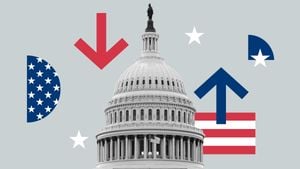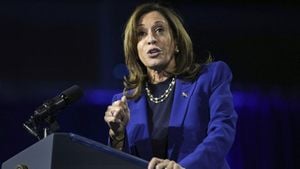On October 31, 2024, as the clock ticks down to Election Day, the U.S. Labor Department released its final jobs report before the pivotal day of voting, showcasing troubling signs for the economy. With only 12,000 jobs added last month, the report marks a sharp decline from September's solid gain of 223,000 jobs. Economic analysts point to temporary but significant disruptions caused by Hurricanes Helene and Milton, as well as labor strikes, particularly at Boeing, as primary factors contributing to this disappointing figure.
The report, released just days before voters head to the polls, creates additional hurdles for the Biden administration and Vice President Kamala Harris. Given the economy's longstanding position as the foremost concern for American voters, the weak numbers could hand Republicans, especially former President Donald Trump, ammo for their critiques of Harris's leadership.
The unemployment rate held steady at 4.1%, consistent with last month's statistics. Experts stress there’s more beneath the surface of these numbers. Lauren Saidel-Baker, an economist at ITR Economics, explained the discrepancies between job creation and the unemployment rate, noting, "That’s really where we see the difference between... the unemployment rate... against this very disappointing jobs figure." This divergence results partly from the distinction between household and establishment surveys during strikes, where strikers technically remain employed, but absence during the strike is noted by employers.
Preliminary estimates also highlighted the sharp losses felt by the manufacturing sector, which shed 46,000 jobs, primarily due to the prolonged strike against Boeing, where workers are demanding increased wages and improved benefits. The impacts of these strikes, combined with the storms, obscure the economic picture but provide ample talking points for both sides of the political aisle during the final campaign push.
While the numbers reflect immediate concerns, other indicators suggest there could be resilience within the economy. Average hourly earnings rose by 0.4% this October, translating to an increase of 4% over the past year, indicating workers are earning more even as job creation stagnates. This situation reinforces the challenge of reconciling healthy wage growth against the backdrop of historically high inflation rates.
Despite the mixed signals, many analysts assert there is no immediate cause for alarm. For example, Carlos Martin, a senior fellow at Brookings Metro, remarked on the possible long-term effects of climate-driven displacement but emphasized the resilience of businesses and their workforce within affected areas.
Notably, the report's mixed results come as both parties strategize their closing arguments for voters who have remained largely dissatisfied with the economy, pointing to steeply rising prices for everyday goods as contributing to this sentiment. Analysts indicate, this discontent may not be changing, irrespective of the broader economic indicators pointing to recovery from the pandemic dips.
Compounding the complexity is the widespread labor unrest as workers across various industries express frustration over inadequate working conditions, reflecting continued impacts from the COVID-19 pandemic. Striking workers from different sectors have created significant challenges for employers and overall productivity, driving fears of potential labor shortages. For example, hotel and restaurant workers are also engaging in activism, demanding improved benefits and wage increases to alleviate pressures stemming from staffing shortages post-pandemic.
The Federal Reserve is closely watching these fluctuations, as they will impact decisions on interest rates in the upcoming months. A stagnant jobs market could prompt the Fed to initiate policy changes sooner rather than later, affecting everything from mortgage rates to credit card interest rates. While rate cuts are anticipated following this week's meeting, observers suggest the Fed will not react impulsively to this one jobs report, acknowledging the extraordinary influence of the hurricanes and strikes.
Both the Biden-Harris ticket and Trump’s campaign are carefully calibrate their messages leading to Election Day. Harris is attempting to highlight positive wage growth and the broader recovery underway, whereas Trump’s campaign immediately labeled the jobs report as evidence of Harris's failure to manage the economy effectively, accentuating the vulnerabilities of the Democratic position.
This election's economy-themed narratives may greatly influence swing voters, particularly as both parties attempt to retain significant support among working-class individuals who have historically faced challenges during economic downturns. While Trump's base has felt energized by voter dissatisfaction toward the Harris administration, local sentiment on the election's eve remains uncertain. Polls indicate the vice president has gained ground among voters recently, thanks to her emphasis on progressive economic policies and labor advocacy.
Looking past the immediate chaos created by the labor movements and environmental calamities, economists are stressing the longitudinal perspective — the economy is overall more stable than it appears on the surface. A key component of this stability includes the various areas of job creation where demand remains consistent, such as healthcare, public services, and several sectors of construction.
The crescendo of these developments leads to one central point: undecided voters, who typically prioritize economic factors, will watch how each party interprets these statistics closely as they head to the ballot box. The ability of Harris and her campaign to navigate their messaging amid the forthcoming challenges will be pivotal for their potential re-election bid. Conversely, whether Trump can capitalize on this latest report as definitive proof of economic failure under Democratic governance remains to be seen, as public perception will solidify quickly with just days left until voters make their decisions.
Despite the messiness of October’s report, there is still ground to cover before realizing the full imprints of these strikes and weather-related disruptions. What’s clear, as we look toward November 3rd, is how economic sentiments travel beyond just the figures on paper.



